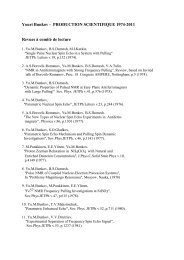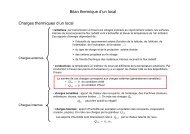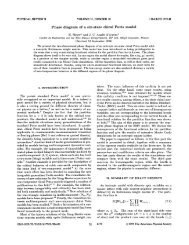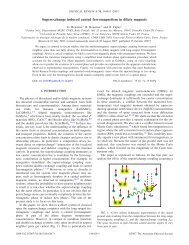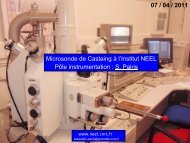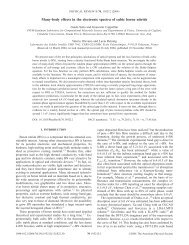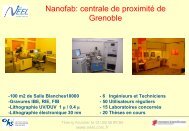Activity Report 2010 - CNRS
Activity Report 2010 - CNRS
Activity Report 2010 - CNRS
You also want an ePaper? Increase the reach of your titles
YUMPU automatically turns print PDFs into web optimized ePapers that Google loves.
HIGHLIGHT : NANO APPROACHES TO LIFE SCIENCES<br />
CONTACTS<br />
tetiana.aksenova@cea.fr<br />
corinne.mestais@cea.fr<br />
FURTHER READING<br />
Eliseyev et al., LNCS, 6792, 2011 (in press)<br />
IMPLANTABLE<br />
COMPUTER BRAIN<br />
INTERFACE<br />
Up to now, drugs were the main way for<br />
a physician to repair the brain and its<br />
connections to the rest of the body. Deep<br />
brain stimulation has nevertheless<br />
already demonstrated the interest of local<br />
stimulation to correct neural circuit<br />
defects using implantable electrodes.<br />
Nanotechnologies, allowing to record,<br />
stimulate or deliver drugs to neurons<br />
with an unprecedented (unmatched,<br />
unrivaled) resolution will surely help<br />
developing some of the tomorrow’s<br />
neurological treatments. Development of<br />
robust brain-computer interfaces is a key<br />
issue for these progresses.<br />
Development of selflearning<br />
adaptive solutions<br />
for the control of<br />
mechanical effectors<br />
Chair of Excellence 2008: Tetiana<br />
AKSENOVA<br />
Severe motor disabilities require the<br />
development of new communication<br />
pathways to allow the patient controlling<br />
efficiently and safely external aids, such<br />
as wheelchairs and prostheses. The<br />
current method consists in redirecting the<br />
injured nerves into non-essential muscles<br />
and using the electric signals associated<br />
to muscle contraction to monitor the<br />
patient’s intention. The aim of the “Brain-<br />
Computer Interface” project (BCI) is to<br />
directly interpret the brain neural activity<br />
and to translate it into useful command<br />
signals. “Motor signals” are relatively<br />
large in the brain, and can thus be<br />
discriminated from the other neural<br />
activity.<br />
In fact, this work consists in developing<br />
and implementing innovative signal<br />
processing algorithms to analyze<br />
Electrocorticographic signals (ECoG:<br />
electric signals recorded at the surface of<br />
the brain). Animals were instrumented<br />
with ECoG electrodes and trained to<br />
press a pedal to get food at their will,<br />
while ECoG signals were recorded. After<br />
training, a “predictor” was built that could<br />
successfully predict the animal’s intention<br />
(Fig. 1 & 2).<br />
One of the prominent features of this<br />
algorithm is that the success of the<br />
detection is stable for several months<br />
without recalibration, which is very<br />
important for future patient<br />
rehabilitation. Brain computer interface<br />
experiments are now in progress in nonhuman<br />
primates (the step toward human<br />
implantation) and show promising<br />
results.<br />
A<br />
B<br />
Fig. 1: scheme of the brain-computer interface<br />
experiments.<br />
A: training stage, the recorded signals are<br />
used to calibrate the algorithm.<br />
B: the algorithm is used to command the<br />
reward distributor.<br />
Fig. 2: A real-time brain computer interface<br />
experiment. The rat presses the pedal but<br />
decision whether to give a reward is made on<br />
the basis of the recorded ECoG signal.<br />
Although it is still necessary to further<br />
improve the reliability of the detection,<br />
these results successfully demonstrate<br />
that electrocortical electrodes could be<br />
used to control external mechanical<br />
devices and thus rehabilitate paralyzed<br />
people.<br />
Of course, a less invasive system is under<br />
development, consisting in electrodes to<br />
record ECoG signals and circuits to<br />
ensure wireless transmission to the<br />
computer. The first implantation is<br />
scheduled for 2012.<br />
15



